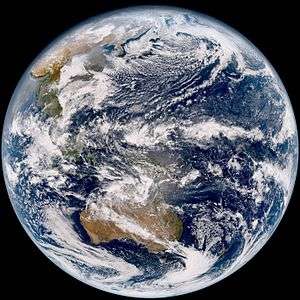Himawari 9
Himawari 9 is a Japanese weather satellite, the 9th of the Himawari geostationary weather satellite operated by the Japan Meteorological Agency. The spacecraft was constructed by Mitsubishi Electric, and is the second of two similar satellites to be based on the DS-2000 bus.[2]
| Mission type | Weather satellite |
|---|---|
| Operator | JMA |
| COSPAR ID | 2016-064A[1] |
| SATCAT no. | 41836 |
| Mission duration | 8 years (planned) |
| Spacecraft properties | |
| Bus | DS-2000 |
| Manufacturer | Mitsubishi Electric |
| Launch mass | 3500 kg |
| Dry mass | 1300 kg |
| Power | 2.6 kilowatts from solar array |
| Start of mission | |
| Launch date | 06:20:00, November 2, 2016 (UTC) |
| Rocket | H-IIA 202 |
| Launch site | Tanegashima LA-Y1 |
| Contractor | Mitsubishi Heavy Industries |
| Orbital parameters | |
| Reference system | Geocentric |
| Regime | Geostationary |
| Longitude | 140° East |
| Epoch | Planned |
Launch
Himawari 9 was launched on 2 November 2016, 06:20:00 UTC, atop a H-IIA rocket flying from the Yoshinobu Launch Complex Pad 1 at the Tanegashima Space Center, and by 11 November 2016 it reached to the geostationary point at 140.7 degrees East.[3] After initial function tests, it was put on standby until 2022, when it will succeed Himawari 8.[4]
The launch was scheduled initially on 1 November 2016, but postponed for one day due to the bad weather forecast.
At launch, the mass of the satellite is about 3,500 kilograms (7,700 lb). It has a design life of 15 years with 8 years of operational life. Power is supplied by a single gallium arsenide solar panel, which provides up to 2.6 kilowatts of power. The main instrument aboard Himawari 9 is a 16 channel multispectral imager to capture visible light and infrared images of the Asian-Pacific region.[5]
As part of an outreach project organized by the Young Astronauts Club Japan the launch also carried manga artwork drawn by Chūya Koyama, author of the Space Brothers manga.[6]
Gallery
 The first true-color image from Himawari 9
The first true-color image from Himawari 9
References
- "Himawari 9". NASA Space Science Data Coordinated Archive.
- Graham, William. "Japan lofts Himawari 8 weather satellite via H-IIA rocket". NASASpaceflight.com. Retrieved 7 October 2014.
- 「ひまわり9号」の静止化の完了について (in Japanese). Japan Meteorological Agency. 11 November 2016. Retrieved 11 November 2016.
- "JMA/MSC: Himawari-8/9". Japan Meteorological Agency. Retrieved 7 October 2014.
- "New geostationary meteorological satellites — Himawari-8/9 —" (PDF). Japan Meteorological Agency. Retrieved 7 October 2014.
- "Japanese rocket decked out in manga art launches satellite into space". Hindustan Times. 2016-11-02. Retrieved 2020-06-25.
External links
- Meteorological Satellite Center of JMA
- Himawari 9 3D model from Asahi Shinbun